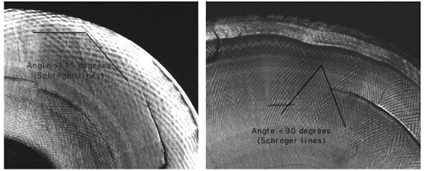Zelandia: Ivory Ethics
ANCIENT IVORY VS NEW IVORY - IVORY ETHICS
Zealandia jewelry is made from ancient fossilized walrus and mammoth ivory. These animals have been deceased from anywhere between 500 to over 15,000 years, and their ivory has lain in the earth or permafrost for centuries where it gathers its unique coloring from the surrounding environment.
As of 1989 all imports of African elephant ivory into the United States, in any form, are banned. Zealandia respects and supports all laws and conservation efforts created to protect elephants and endangered animals worldwide. We have never traded in elephant or endangered ivory and stand entirely in opposition to the practice. All of our ivory is sourced from ancient animals long ago deceased or extinct.
Mammoth Ivory and Schreger Lines
Proboscidian (tusk) ivory is identified by the grain pattern that is visible in its cross section. These patterns, which are called Schreger Lines, are formed by a series of spirals running clockwise and counter clockwise over one another. This pattern resembles a star. When this star's points have acute angles the ivory is mammoth or mastodon, which means it is ancient fossilized ivory and that the mammoth ivory for sale is legal. If the points have obtuse angles the ivory is from modern elephants and therefore illegal. These lines can be easily identified under a microscope.
Evaluation of Schreger lines was developed by the U.S. Fish and Wildlife Service in order to keep any elephant ivory from entering the country disguised as legal mammoth ivory for sale. These Schreger lines, or patterns in the cross sections, can be examined to determine if the ivory came from mammoths or elephants. As the woolly mammoth has been extinct for over 10,000 years, their ivory is not protected by regulation and is used to make a variety of carved art, mammoth ivory jewelry, and other crafts.

Elephant ivory Mammoth ivory
You may read more about how the U.S Fish and Wildlife Service identifies different types of ivory: http://www.fws.gov/lab/ivory_natural.php
Fossilized Walrus Ivory
Walrus ivory is easily differentiated from elephant ivory and mammoth ivory as walrus ivory is a tooth rather than a tusk and as such does not have any Schreger lines. These walrus teeth have a unique marble like quality, with an outer dentine layer and a mottled inner core, as with all teeth. Trade in walrus ivory is regulated by the United States Fish and Wildlife Service and an international agreement entitled the Convention on International Trade in Endangered Species (CITES).
Only Eskimos and Aleuts may legally carve new walrus. Sale of uncarved, new walrus is illegal. However, because fossilized walrus ivory is ancient and not obtained from living animals it can be legally traded and carved. The import and export of fossilized walrus ivory is closely monitored by the Fish and Wildlife Departments of each country in accordance with CITES to ensure it is ancient material in order to protect these wonderful creatures.
The ancient walrus ivory Zealandia uses is excavated by native Eskimos from islands off the coasts of Alaska and Siberia, and has been in the ground or ocean anywhere from 300 – 5,000 years. Fossilized walrus ivory is one of the rarest and most beautiful ivories available. Zealandia’s walrus ivory is excavated by the Bering Straits Inuit from privately owned land within old villages and hunting sites. This fossilized walrus ivory has slowly taken on an exotic array of warm colors ranging from creams and golden tans to chocolate browns due to the mineral deposits in the environment where it has lain for centuries.
Our Products
Zealandia does not compete with native Inuit or Eskimo handicrafts and supports these communities through fair trade. It is our goal to honor their wisdom and promote their livelihoods, not copy their work or exploit their traditions.
There is a limited supply of both fossilized walrus tusk and fossilized mammoth ivory as they are finite products and can only be excavated during the short arctic summer. At Zealandia Designs we take pride that our pieces of walrus ivory and mammoth ivory jewelry are timeless artifacts and are considered heirloom pieces that our customers can pass down for generations.
We believe making jewelry with fossilized mammoth ivory and walrus ivory is a beautiful way to honor and commemorate these majestic creatures. The distinctive character and growing rarity of fossilized ivory makes each piece a truly lasting, one of a kind, piece of art that you'll be happy to wear and proud to give as a gift.
